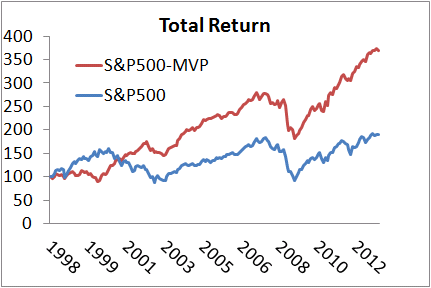Ronnie Shah has a new piece on low volatility investing (Residual Volatility and Average Returns, Dec 2012) and as he works for Dimensional Fund Advisors, I presume his take is consistent with that of the Dimensional management. As this would include Eugene Fama, Ken French, Robert Merton, Roger Ibbotson, Myron Scholes and George Constantinides, I think it represents conventional academic financial wisdom about as well as any firm can.
The old guard continues to think nothing's wrong with the standard theory, a three-factor model that includes value and size proxies (ie, long high book-market/low cap, short low book-market/high cap) as well as the market (as in the traditional Capital Asset Pricing Model). The market factor does not work within equities, but 'explains' the relative premium in equity indices over bonds; the size and value factors explain, well, themselves (the size and value anomaly). That is, all factors are chosen to explain themselves. While the market factor has some theoretical justification, value and size proxy are factors we still, after about 30 years, haven't identified. That this is considered a logical, rigorous, theory highlights to me that smart people are willing to accept a lot of rationalization to keep their paradigm alive.
Low vs. Residual Volatility
In any case, Shah's argument is that low volatility is not an anomaly because if you sort by residual volatility, among the high cap/value stocks, there's an insignificant difference between the low and high volatility stocks.
I think he's conveniently ignoring a lot of arguments, instead focusing on a simple statistic that, while logically correct, is rather selective. That is, minimum volatility portfolios taken within the SP500, since 1998, generate a large 3.9% difference in annual returns with the SP500 (this is just multiplying the monthly returns by 12). Look at the results below (data are from here). That's statistically insignificant, however, given standard t-stats, and if things continue, will become significant around 2050. Such is the nature of financial time series.
Handicapped Results
I haven't broken out a low 'residual volatility' portfolio because I think it's really total volatility that is the key, and so using residual volatility handicaps the results. Note that there's no beta premium, and so from a return perspective this doesn't hurt, and lower systematic volatility (ie, beta) is also a good thing for a portfolio.
More importantly, even if there's no low-volatility premium, the fact that you can generate the same return for one-third the beta, or total volatility, then anyone who believes in mean-variance optimization (as the Dimensional Star Chamber does) should love low volatility investing much more than value or small cap investing.
Data Points
Lastly, just because high volatility stocks tend to be small cap and have high spreads, does not mean they aren't good data points. It's true that you can't really arbitrage the poor returns on high volatility stocks because they are often illiquid, but note that lots of people own these stocks and they seem strictly dominated in the sense of Rothschild and Stiglitz (Increasing Risk I, 1970). The fact you can't short them efficiently, still begs the question why anyone would own these. Further, given their high transaction costs, the holding period should be long, and what really kills these stocks is the compounding, as their volatility is about 40%, which generates an 8% drag on geometric returns (Geometric Return=arithmetic Return-variance/2). That people buy these lottery tickets is impossible to reconcile with the model where people are maximizing a standard utility function.
This will be an example of Max Planck's dictum that science increases funeral by funeral, because these guys aren't about to give their standard model the root canal I think it deserves. As shown above, you can have meaningfully large opportunities that won't look statistically significant for 50 years, so, if you have a strong prior, there's no logical reason you have to give it up in this life.
- English (UK)
- English (India)
- English (Canada)
- English (Australia)
- English (South Africa)
- English (Philippines)
- English (Nigeria)
- Deutsch
- Español (España)
- Español (México)
- Français
- Italiano
- Nederlands
- Português (Portugal)
- Polski
- Português (Brasil)
- Русский
- Türkçe
- العربية
- Ελληνικά
- Svenska
- Suomi
- עברית
- 日本語
- 한국어
- 简体中文
- 繁體中文
- Bahasa Indonesia
- Bahasa Melayu
- ไทย
- Tiếng Việt
- हिंदी
Dimensional's Latest On Low-Volatility
Published 01/07/2013, 10:10 AM
Updated 07/09/2023, 06:31 AM
Dimensional's Latest On Low-Volatility
Latest comments
Loading next article…
Install Our App
Risk Disclosure: Trading in financial instruments and/or cryptocurrencies involves high risks including the risk of losing some, or all, of your investment amount, and may not be suitable for all investors. Prices of cryptocurrencies are extremely volatile and may be affected by external factors such as financial, regulatory or political events. Trading on margin increases the financial risks.
Before deciding to trade in financial instrument or cryptocurrencies you should be fully informed of the risks and costs associated with trading the financial markets, carefully consider your investment objectives, level of experience, and risk appetite, and seek professional advice where needed.
Fusion Media would like to remind you that the data contained in this website is not necessarily real-time nor accurate. The data and prices on the website are not necessarily provided by any market or exchange, but may be provided by market makers, and so prices may not be accurate and may differ from the actual price at any given market, meaning prices are indicative and not appropriate for trading purposes. Fusion Media and any provider of the data contained in this website will not accept liability for any loss or damage as a result of your trading, or your reliance on the information contained within this website.
It is prohibited to use, store, reproduce, display, modify, transmit or distribute the data contained in this website without the explicit prior written permission of Fusion Media and/or the data provider. All intellectual property rights are reserved by the providers and/or the exchange providing the data contained in this website.
Fusion Media may be compensated by the advertisers that appear on the website, based on your interaction with the advertisements or advertisers.
Before deciding to trade in financial instrument or cryptocurrencies you should be fully informed of the risks and costs associated with trading the financial markets, carefully consider your investment objectives, level of experience, and risk appetite, and seek professional advice where needed.
Fusion Media would like to remind you that the data contained in this website is not necessarily real-time nor accurate. The data and prices on the website are not necessarily provided by any market or exchange, but may be provided by market makers, and so prices may not be accurate and may differ from the actual price at any given market, meaning prices are indicative and not appropriate for trading purposes. Fusion Media and any provider of the data contained in this website will not accept liability for any loss or damage as a result of your trading, or your reliance on the information contained within this website.
It is prohibited to use, store, reproduce, display, modify, transmit or distribute the data contained in this website without the explicit prior written permission of Fusion Media and/or the data provider. All intellectual property rights are reserved by the providers and/or the exchange providing the data contained in this website.
Fusion Media may be compensated by the advertisers that appear on the website, based on your interaction with the advertisements or advertisers.
© 2007-2024 - Fusion Media Limited. All Rights Reserved.
